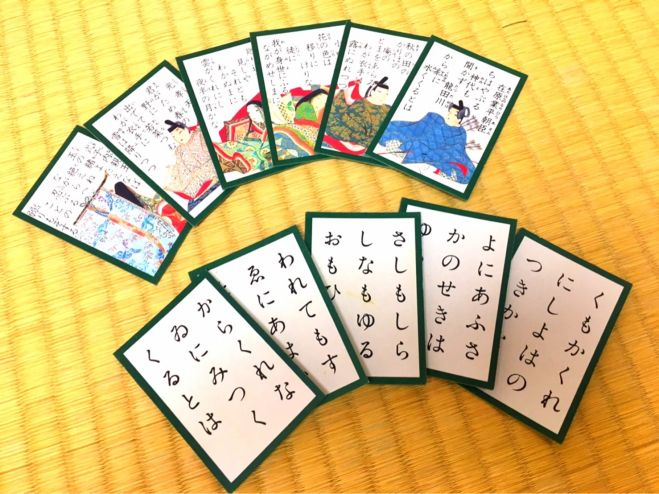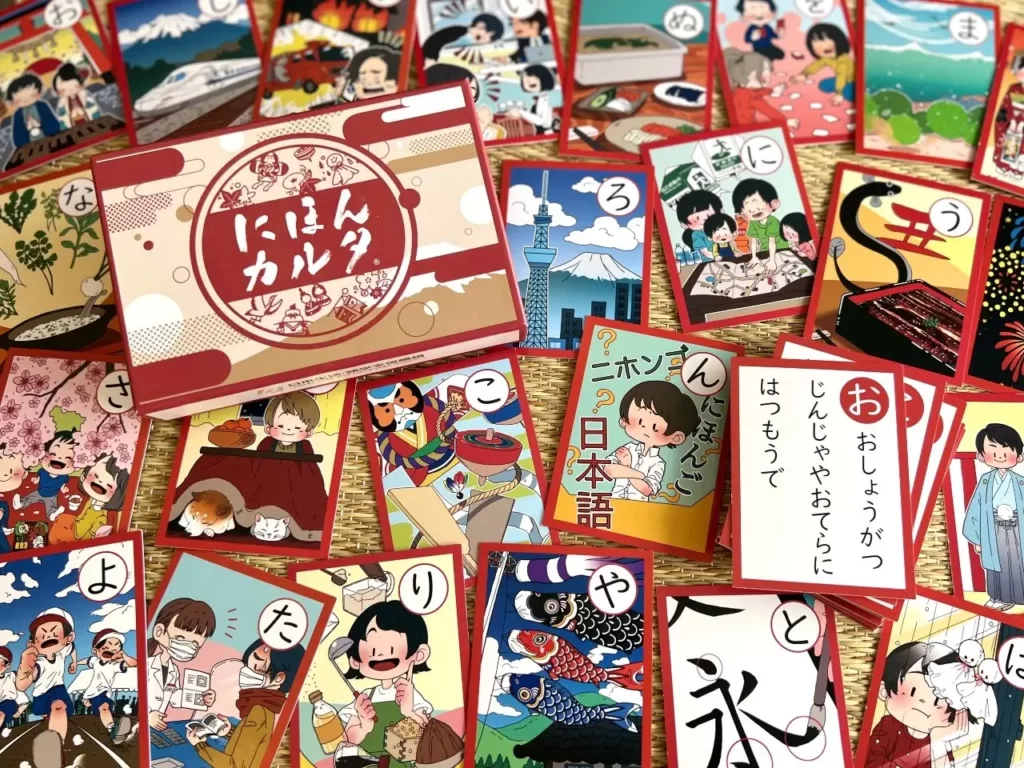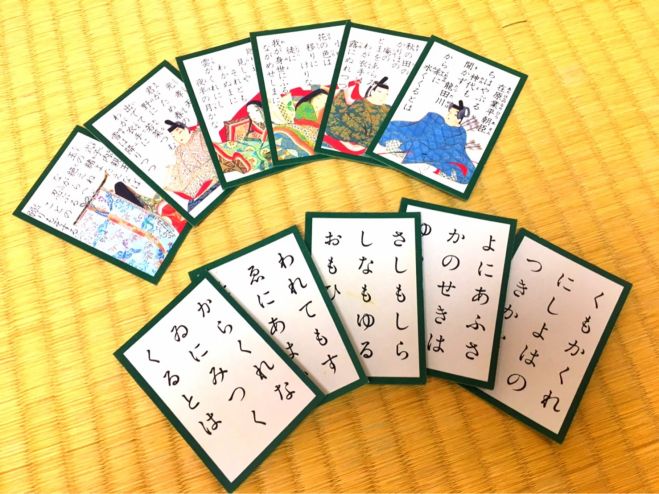Chapter 1: Introduction to Karuta
I think there are many people who don’t know about Karuta, which is an important part of Japanese culture, so I would like to introduce it to you.
Karuta is a game unique to Japan that is played using cards with poems, songs, proverbs, etc. written on them. The name is said to come from the Portuguese word “carta” (card). In this game, a reader reads part of a poem or song, and participants quickly pick up a card with the next part written on it. Although the rules are simple, it tests participants’ knowledge, concentration, and physical reaction speed, so it is enjoyed by people of all ages.
There are many different types of karuta, but one that deals with classical literary poetry called “Hyakunin Isshu” is particularly famous. Hyakunin Isshu Karuta is featured in Japanese junior high school textbooks, and many Japanese people will have had the opportunity to experience it at least once. One of the attractions of Karuta is that you can experience classical literature and the historical background of Japan.
Karuta is also played as a competition. In particular, competitive karuta'' has precise rules and referees, and tournaments are held nationwide. Among them, theNational Karuta Tournament” is the biggest event in the karuta world, with many competitors competing to become the best.
On the other hand, karuta as a daily game still remains popular. Karuta is an indispensable part of many Japanese people’s lives, whether it’s simple entertainment when gathering with family and friends, or a way to spend the New Year. There are many different types of karuta, from the traditional “Hyakunin Isshu” to children’s karuta with pictures of animals, vehicles, fruits, etc., and you can enjoy it to suit the age and interests of the participants.
Overall, karuta is deeply rooted in Japanese culture. This game, which combines competitiveness that requires knowledge, skill, and concentration, with the aspect of being a communication tool with family and friends, will continue to be popular among many Japanese people.

Quote (https://www.kokuchpro.com/event/dc5972fab17cca15fc638fdd54d4791b/)
Chapter 2: Historical and cultural background
We will tell you how Karuta has developed in Japan until now, including history and culture.
The origins of karuta are said to date back to playing cards brought to Japan by Portuguese ships in the 16th century. Over time, the Portuguese word “carta” has become integrated into Japanese culture as “karuta.” The first karuta had Western designs and was similar to European card games, but over time it became associated with Japan’s unique culture and developed in its own way.
In the Edo period, karuta became a popular game among the common people. During this period, with the spread of reading and writing, educational karuta, which combined pictures and songs, appeared. The names of plants and animals and historical events were used as topics to increase children’s knowledge.
In particular, karuta, based on a collection of poems called “Hyakunin Isshu,” was created during this period and became extremely popular. Hyakunin Isshu is a collection of 100 tanka poems written by Japanese poets about love, landscapes, and the changing seasons, and the karuta based on these poems is still loved by many people today. Masu.
Additionally, in the latter half of the 19th century, karuta manufacturing technology evolved and higher quality karuta began to be produced. These karuta cards, printed with beautiful pictures and poems, also became popular collector’s items.
Even in modern times, karuta has established itself as a part of Japanese culture. In particular, more and more people are taking up “competitive karuta” as seriously as a sport. Tournaments of all sizes, including national karuta tournaments and local tournaments, are held, and interest from participants and spectators is increasing.
In addition, in recent years, anime and movies with the theme of “Karuta” have appeared, giving people a chance to rediscover the appeal of karuta.
Overall, karuta has been deeply connected to Japanese history and culture. Its presence continues to this day, from entertainment as a form of entertainment to educational and competitive aspects. By understanding this history and cultural background, you will be able to appreciate the charm of karuta even more deeply.
Chapter 3: Karuta in modern times
Let me introduce you to what Karuta is like in modern Japan.
In modern Japan, karuta is widely accepted not only as a traditional game, but also as a competition and an educational tool. In particular, “competitive karuta”, as the name suggests, treats karuta as a competition, and there are specialized associations and groups, and large-scale tournaments such as national tournaments are held regularly.
These competitive karuta tournaments are increasingly being covered on TV, and many people are able to see the players’ fascinating plays and the heated battles. In particular, the National Karuta Tournament, which is held from the end of the year to the beginning of the new year, is a big event not only for the participants but also for those watching.
Karuta is also used as a very effective teaching material in school education. Karuta is often used in classes when learning about Japanese traditional culture, history, and classical literature. In particular, “Hyakunin Isshu” Karuta is used in many schools as a tool to learn about the beauty and historical background of tanka.
On the other hand, in modern lifestyles, Karuta cannot be overlooked as a communication tool with family and friends. Karuta is often chosen as an easy game to play during New Year’s events and family gatherings.
In recent years, karuta-themed works have appeared in the entertainment world, including anime, movies, and novels. Through these works, the appeal of karuta is being conveyed to new generations.
Overall, in modern Japan, karuta exists in everyday life in various forms. While retaining its value as a tradition, Karuta continues to evolve to meet modern needs, giving us a sense of the depth and breadth of Japanese culture.

Quote (https://prtimes.jp/main/html/rd/p/000000009.000074481.html)
Chapter 4: Famous works featuring Karuta
We will introduce some famous works featuring Karuta.
In recent years, the number of entertainment works with Karuta as a theme has been increasing, and among them, anime, movies, novels, etc. are attracting particular attention. Through these works, the charm of karuta and the Japanese culture and history behind it are being conveyed to many people.
First of all, Chihayafuru is a very famous anime/manga. This work depicts the world of competitive karuta, centered around high school girls. Incorporating elements such as heated battles, friendship, and love, it not only makes you feel the deep appeal of karuta, but also serves as an opportunity for viewers and readers to become interested in competitive karuta.
Next, from the film world, there are the live-action movie version of Chihayafuru'' andThe Murder Case of Hana and Alice.” These movies also have karuta-based stories, and the live-action version of “Chihayafuru” in particular has received high praise not only from fans of the original work but also from movie fans.
Even in the field of novels, there are many works with Karuta as the theme. Among them, the novel “Queen of Karuta” depicts the life of a woman who pursues competitive karuta, and leaves a deep impression on readers.
Through these works, we can convey the unique charm of karuta, the Japanese culture and history behind it, and the passion and way of life of the people. It is also said that these works have inspired an increasing number of people to actually start playing karuta.
Overall, karuta-themed works play an important role in conveying the charm of traditional culture to many people. Through the unique stories and characters of each work, you can rediscover the depth and breadth of Japan’s beautiful culture, Karuta.
Chapter 5: Summary
This is a summary about Karuta.
Karuta, which we will focus on in this series, is a traditional Japanese card game that has been enjoyed by many people for a long time. This game is more than just a game, it reflects Japanese culture and history, as well as Japanese sensibilities and values.
By learning about the origins of karuta and its cultural background, you can experience Japanese classical literature and history. In addition, I was able to rediscover the charm of karuta through the modern appearance of karuta and various entertainment works that feature it.
Karuta has continued to evolve with the times, but its roots lie in the Japanese aesthetic sense, sensitivity, and joy of communication. The tension behind the scenes of competitive karuta, the peaceful playing of karuta at home, and learning through karuta at school. All of these points to the universal appeal that karuta has.
There is no doubt that many people have gained a new interest in this traditional card game through various Karuta-themed works. This shows that we have the power to create new cultural value by fusing tradition and modernity.
Finally, Karuta is more than just a game. It is a mirror that reflects Japan’s beautiful climate, history, and people’s hearts, and is an important cultural heritage for us. We hope that many people will continue to enjoy this traditional card game and pass on the beautiful culture of Japan to the next generation.
